#nagaharu yodogawa
Explore tagged Tumblr posts
Text

映画のおしゃべり箱 淀川長治 中央公論社 装幀=丸山邦彦
3 notes
·
View notes
Text
Maybe it was a different Nagaharu Yodogawa voicing Big Bird in the Japanese dub.
0 notes
Text
Funeral Parade of Roses by Toshio Matsumoto
The film "Funeral Parade of Roses," directed by Toshio Matsumoto and released in 1969, is an avant-garde movie featuring a gay boy as the protagonist, made with experimental visuals and structure. Eddie, a popular figure in the gay bar scene, is the lover of the owner and vies for the position of "Mama." Triggered by certain events, memories begin to resurface. While the content itself is quite serious, elements like music and fast-forwarding add a comedic touch, allowing the audience to watch without feeling too downcast. It was a film rich in playful elements, incorporating various avant-garde techniques. This was the first time I had seen an underground film, and although I found it confusing, I could enjoy watching it.
Although there were many impressive editing and directing choices, I will mention some that left a particular impression on me. Firstly, what stood out the most was the frequent use of flash cuts and the techniques where footage that the characters are watching becomes integrated into the film itself blurring the lines between what the characters see and what the audience sees. , such as a scene in which a disturbed image is suddenly shown and it turns out to be what the characters are watching on TV. This made me feel strangely unsettled, as I could sense the tension and suspense that the characters must have been experiencing. The occasional inclusion of poems or images was challenging for me to decipher, but I found the prospect of different interpretations intriguing. Flashbacks and repeated scenes made it difficult to grasp the timeline initially, but the shifting meanings kept it engaging, allowing for a gradual understanding of the overall narrative.
The use of documentary-style interviews with gay boys added a sense of realism to the fictional story, blurring the lines between fiction and reality. Knowing that people like the characters actually exist added a current, realistic dimension to the film. However, I found the scenes showing behind-the-scenes footage, including the staff and filming equipment, the scene where one of the actors messed up their lines, and the interview footage with Peter, who plays the protagonist, Eddie, discussing his thoughts on the character and why he wanted to take on the role, to be amusing but left me somewhat confused about whether they were part of the story or behind-the-scenes footage. Also, the deliberate use of contrast inversion and blown-out whites added vibrancy to the black-and-white imagery, which I appreciated.
There were many memorable scenes, such as the one where everyone passes around marijuana, gets high, and dances, or when Eddie is approached by guys on the street, shown from their perspective and use of the jump cuts. However, the most memorable scene in terms of direction for me was the fight scenes. In the scene where Eddie and Leda quarrel, there are Western cowboy-style elements that come to mind, but suddenly, speech bubbles appear, and they start exchanging insults. In the scene where three girls and three gay boys fight in the street with pop music and fast-forwarding. Like these scenes, there are many instances where the direction takes a comical turn, creating a starkly humorous impression contrasting with the seriousness of the content. And above all, the innovative use of the film commentator Yodogawa Nagaharu was incredibly amusing. "Sayonara, sayonara, sayonara…"
Mirrors seemed to be a key motif in this film. From the beginning, there were numerous instances where the camera transitioned from a reflection in the mirror to the actual scene, blurring the boundaries between illusion and reality. The use of mirrors was skillful, often making me unaware that I was watching a mirrored image until the camera moved. Mirrors seemed to serve as tools for self-awareness. And highlighting aspects like the scene where the character is shaving off their leg hair, emphasizing the chest, or showcasing makeup application, repeatedly reminding the audience of the characters' identities as gay boys. Even in contemporary Japan, issues of sexual identity are often kind of taboo or poorly understood, and I imagine that those living in that era must have grappled with significant internal conflicts and struggles with self-awareness. Human beings constantly wear layers of masks, and self-awareness is inherently complex.
The content itself was cruel and tragic. As evident from the poster referencing "Oedipus Rex," the story is based on the tragedy of Oedipus, who unwittingly kills his father and has sex with his mother, resulting in him seeing hell upon realizing the truth. In this film, Eddie kills his mother and unknowingly engages in a relationship with the owner, his real father. Upon discovering everything, the father commits suicide, and Eddie, mirroring Oedipus, blinds himself with the same knife his father used to end his life. It was visually impactful, so Yodogawa Nagaharu's commentary provided me some relief. The foreshadowing of this ending through the interview footage and the sight of a doll with its eyes pierced by nails beside the fallen figures was particularly intriguing.

4 notes
·
View notes
Photo

Stars Plaza in Tokyo, Japan Asakusa is one of the top destinations in the Tokyo metropolis, millions of tourists coming to see the historic Sensō-ji Temple complex, from which quaint shopping streets stretch on for blocks, with many shops, restaurants, and temples boasting the "oldest of its kind" status. Asakusa's former Sixth District is a good example of this, as it was once at the forefront of cultural modernization, being the site of Japan's oldest movie theatre, skyscraper, and amusement park. The Asakusa Public Hall stands at the end of Orange Street, which runs between the temple complex and the Sixth District. It has hosted traditional kabuki stages, comedy shows, and classical concerts since 1977, so it may not come as a surprise that it is also home to a Japanese version of the Hollywood Walk of Fame called the Stars Plaza. Created in 1979, the Stars Plaza exhibits the handprints and autographs of celebrities associated with Asakusa, from actors to singers, rakugo performers to TV personalities, the number of which grows every year as the celebrities are honored at the Asakusa Performing Arts Awards held every March. The first ones to be awarded the honor included Toshiro Mifune, Hibari Misora, and Kiyoshi Atsumi. The Stars Plaza later went on to include more internationally recognizable figures like Tatsuya Nakadai, Takeshi Kitano, Machiko Kyo, and Nagaharu Yodogawa. Out of them, Mifune remains the only one to have his own star in Hollywood as well as his handprint in Asakusa. https://www.atlasobscura.com/places/stars-plaza-asakusa
0 notes
Photo





Funeral Parade of Roses | Toshio Matsumoto | 1969
Nagaharu Yodogawa
128 notes
·
View notes
Text

6 notes
·
View notes
Text
Togashi’s Comments from the Table of Contents (1990-1994)
WSJ #23 to WSJ #32 (1993)
Volume 14: Chapters 119 to 128
ᐊ Volume 13: Chapters 110 to 118 Volume 15: Chapters 129 to 138 ᐅ
1993
➤ Weekly Shounen Jump N°23 (May 24, 1993)
★ Chapter 119. "Into the Lion's Den...!!" (虎穴に入らずんば・・・!! の巻, Koketsu ni Irazunba...!!)

Table of Contents:

"I'm addicted to Super Famista 2. Hanshin's No 8 is "Togashi". He is a slugger with 59 home runs." - Yoshihiro
🇯🇵 スーパーファミスタ2にはまった。阪神の8番は"とがし"。本塁打59本の強打者だ。 〈義博〉
T/N: Super Famista 2 is a baseball game software for the Super Famicom, published by Namco. It was released in Japan on March 1993. "Slugger" is a hard-hitting batter in baseball.
➤ Weekly Shounen Jump N°24 (May 31, 1993)
★ Chapter 120. "Who's the Mastermind?!" (主謀者 は誰だ!? の巻, Atama wa Dareda!?)
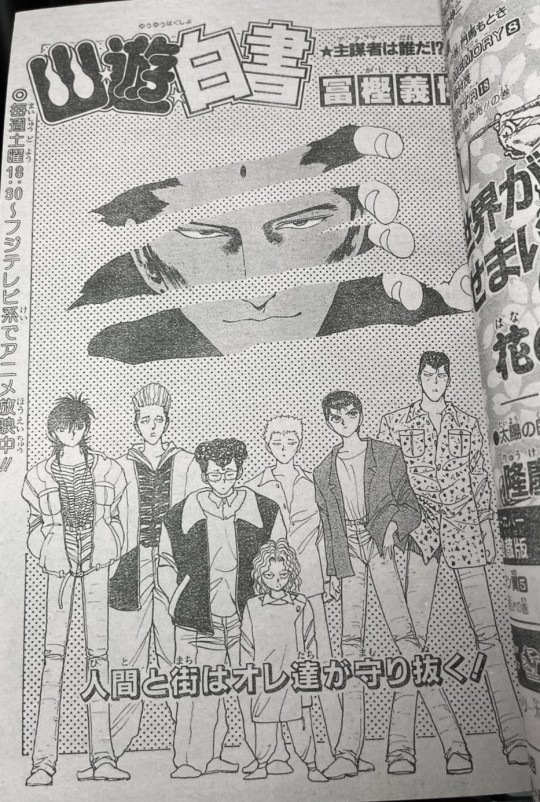

Table of Contents:

"I don't like cutting corners in order to reduce my work schedule, and it's also painful to do that to meet the deadlines. This time it's also the latter." - Yoshihiro
🇯🇵 ス��ジュールをつめるための手抜きはいやだし、締切りのためのそれも辛い。今回も後者です。〈義博〉
➤ Weekly Shounen Jump N°25 (June 7, 1993)
★ Chapter 121. "Murder Surgery!!" (殺人手術!! の巻, Satsujin Shujutsu!!)


Table of Contents:

"I went to my parents' house during the consecutive holidays. It was a good rest, both mentally and physically. I'm fully recharged (!?)" - Yoshihiro
🇯🇵 連休中は実家へ。精神的にも肉体的にも、いい骨休みになりました。充電は十分(! ?) 〈義博〉
T/N: consecutive holidays = The Golden Week.
➤ Weekly Shounen Jump N°26 (June 14, 1993)
★ Chapter 122. "The Cry of a Shadow!!" (影の叫び!! の巻, Shadō no Sakebi!!)

*In this issue: the results of the "9th Catch Phrase Grand Prix" and Yusuke's illustration drawn by Togashi to the winner, a 14-years-old from Kumamoto Prefecture. The winner’s catchphrase was: "A true man's paradise" 「真の男の極楽浄土」*


*Also, the promo of the first Yu Yu Hakusho Movie to the summer of 1993: "A big battle over the Golden Seal". An original screenplay that premiered on July 10th, 1993. The original character Koashura was designed by Togashi-sensei.*
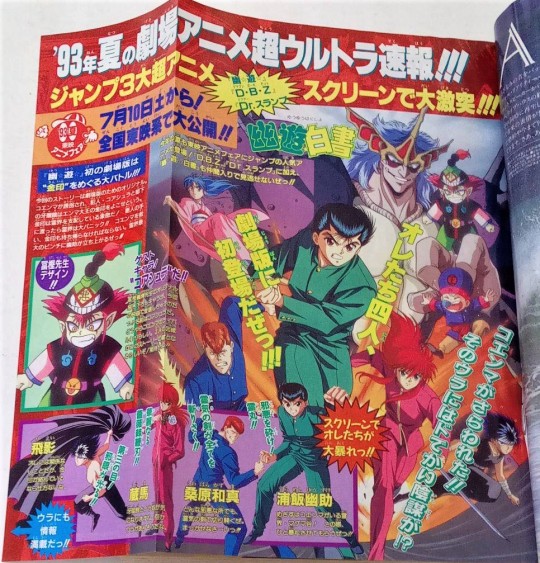
Table of Contents:

"I, the president of the National Unhealthy Alliance, have started playing things like tennis. Togashi, this idiot was scared and hesitant about it." - Yoshihiro
🇯🇵 全国不健康同盟会長の私がテニスなど、はじめてしまいました。冨樫め日和ったな。〈義博〉
➤ Weekly Shounen Jump N°27 (June 21, 1993)
★ Chapter 123. "No Choice...!!" (殺るしかない・・・!! の巻, Yaru Shika nai!!)
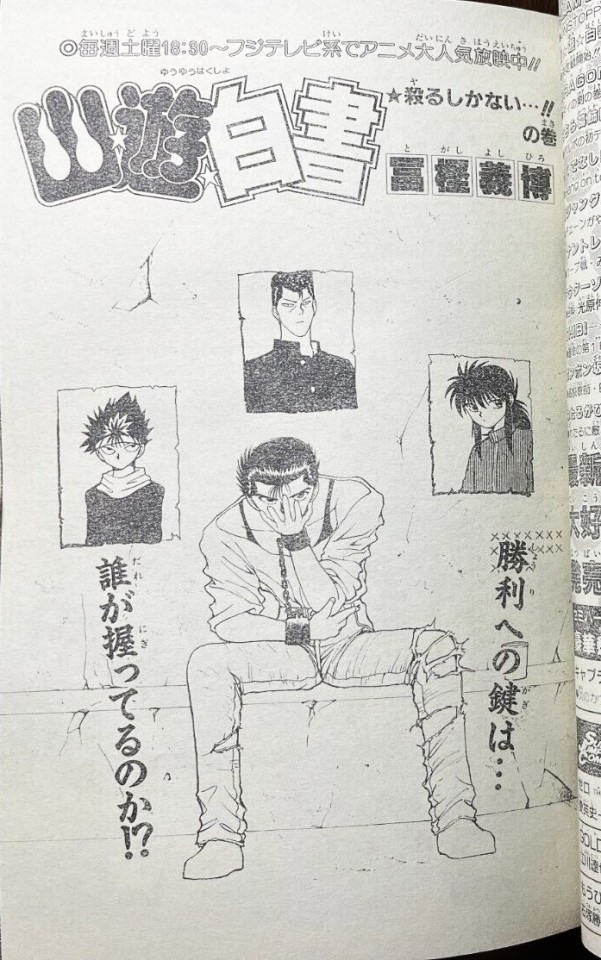
Table of Contents:

"Even now, when I hear the ending of Sunday Western Movie Theater, I feel uneasy and wonder: 'Oh no, school starts again from tomorrow'..." - Yoshihiro
🇯🇵 今だに日曜洋画劇場のエンディング)を聞くと「あーあ明日からまた学校か」という気になる…。 〈義博〉
T/N: TV Asahi's "Sunday Western Movie Theater" (Nichiyō Yōga Gekijō), as the name suggests, broadcast Western movies, mostly Americans, dubbed in Japanese on Sunday evenings. Nagaharu Yodogawa, the late Japanese film critic, was the host of the show until his death in 1998, and was known for closing each program with his signature line "Sayonara, sayonara, sayonara". After his closing lines, the song "So in Love" by Cole Porter was played as the ending theme of the show.
➤ Weekly Shounen Jump N°28 (June 28, 1993)
★ Chapter 124. "Fierce Rain...!!" (激しい雨が・・・!! の巻, Hageshī ame ga!!)

Table of Contents:

"I got hooked on Super Famicom's "Pachinko Monogatari", and used that energy to play real pachinko. I lost badly." - Yoshihiro
🇯🇵 SF/Cの 『 パチンコ物語 』 にハマリ、その勢いで本物のパチンコやったら大敗けした。〈義博〉
➤ Weekly Shounen Jump N°29 (July 5, 1993)
★ Chapter 125. "The Man They've Been Looking For!!" (探していた男!! の巻, Sagashite ita Otoko!!)
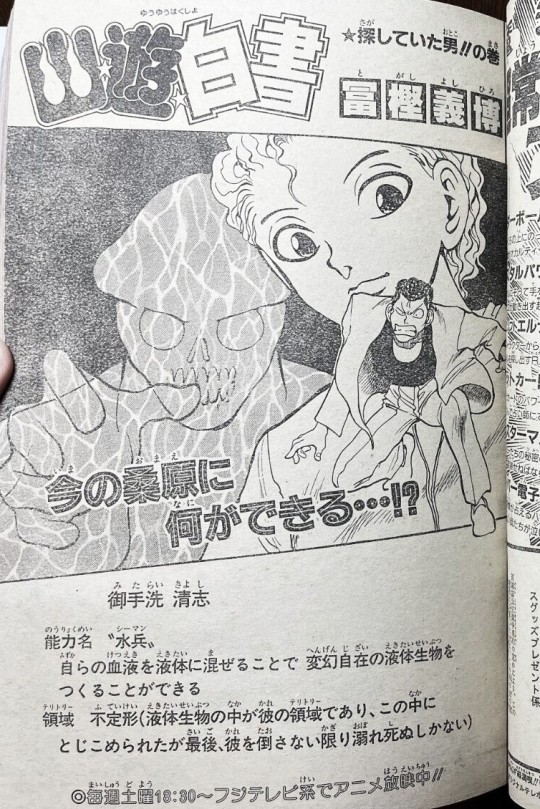
Table of Contents:

"I went from 3 to 4 packs of cigarettes a day to 1 pack at most. When I started playing sports, it naturally decreased..." - Yoshihiro
🇯🇵 1日3〜4箱だったタバコが多くて1箱に。スポーツを始めたら自然に減ったきた…〈義博〉
➤ Weekly Shounen Jump N°30 (July 12, 1993)
★ Chapter 126. "The Black Chapter!!" (黒の章!! の巻, Kuro no Shō!!)

*Yu Yu Hakusho is on the cover of this issue*
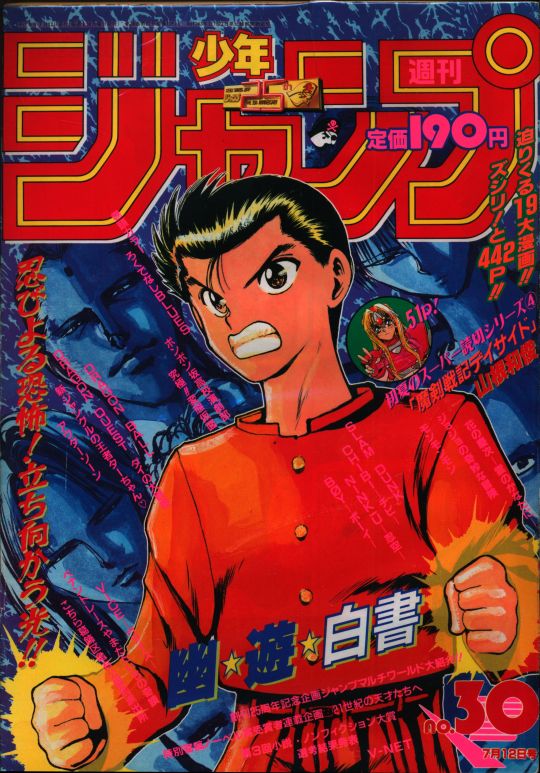
Table of Contents:

"I'm happy because I often have nightmares lately. The other day I woke up on the verge of being killed by a zombie." - Yoshihiro
🇯🇵 最近悪夢をよく見るので嬉しい。先日はゾンビに殺される寸前で目が覚めたのだった〈義博〉
➤ Weekly Shounen Jump N°31 (July 19, 1993)
★ Chapter 127. "A Bloody Past!!" (血塗られた過去!! の巻, Chinura Reta Kako!!)

Table of Contents:

"'Yu Yu' GOODS are arriving at the workplace one after another. It's funny how some of them make me smile wryly." - Yoshihiro
🇯🇵 仕事場に「幽遊」GOODSが次々と届いている。苦笑してしまうものもあって面白い。〈義博〉
➤ Weekly Shounen Jump N°32 (July 26, 1993)
★ Chapter 128. "Aura Lightning Kickboxing!!" (霊光裂蹴拳!! の巻, Reikō Resshūken!!)
Table of Contents:

"The thrice most unpleasant season has arrived. There's nothing more painful than summer when you have a job. Ice Age, please come." - Yoshihiro
🇯🇵 三度いやな季節到来。仕事を持ってる時の夏ほどつらいものはない。氷河期きてくれ。〈義博〉
*On October 4, 1993, Volume 14 (Chapters 119 to 128) was published!*

▼ Togashi’s comment from the dust jacket of volume 14. Translation by VIZ Media.

ᐊ Volume 13: Chapters 110 to 118 Volume 15: Chapters 129 to 138 ᐅ
#weekly shounen jump#table of contents#yoshihiro togashi#Yu Yu Hakusho#volume 14#chapters 119-128#WSJ 23 to WSJ 32 (1993)
20 notes
·
View notes
Text
2022/04/09 English
Once a Japanese critic Akira Asada described Haruki Murakami's novels as 'poor'. This word lets me remember the same word of Nagaharu Yodogawa, who described Mikio Naruse's movies as 'such a poor director'. It looks like a kind of people use 'poor' as a useful adjective. I have lived as a 'poor' person. I won't blame this on someone else. Smart people earn money well even if this corona disease goes on, or they make stepping up their ability through their efforts. So I say to myself that I have to owe the responsibility to my life. I'm poor and it's my fault.
As such a poor person, I have a certain intimacy with 'poor' Haruki Murakami and Mikio Naruse. They might be 'poor' because they are not smart or good at living. Both are the greatest Japanese artists but their works are not 'sophisticated'. Although I don't know Naruse's movies well so I might be wrong, they try to send their messages seriously and directly. Their attitude is different from the humorous one of artists like Jean-Luc Godard. And it might be looked like a 'poor' one.
I can remember this if I watch their 'poor' attitude. The artists like Yasuharu Konishi and Keigo Oyamada show their snob sense by choosing a lot of records with gorgeous elegance that is the opposite of poverty. Yes, their attitude is very rich. I remember I had tried to be like them and showered the music which I can't understand, and tried to be a virtual DJ. It ended as a failure. Now I live a 'poor' life by reading books and watching movies quietly. What is wrong with being 'poor'? Being 'poor' is good! That is my opinion (and this might be very uncool).
Writing this, I think I can't tell this opinion of mine to other foreign readers. I have to explain that they should remember the "Maid" which is famous as a bestseller and a Netflix drama, and the poverty makes me lose the quality of life and sense, therefore becomes uncool. I also might be losing the quality of sense because of poverty. But blaming or laughing at someone else's dumb because it is just uncool is not cool. What am I talking about? Anyway, poverty must be bad absolutely. That's all!
1 note
·
View note
Text
Hula Girl-themed Original Anime Film Hula Fulla Dance Wins Japan Movie Critics Award's Animation Film Award
The winners of the 31st Japan Movie Critics Awards were announced on March 31, and the Shinya Watada (Aikatsu Stars! The Movie)-directed original anime feature film Hula Fulla Dance won the Animation Film Award of 2021. In addition, Keishi Otomo (Rurouni Kenshin: The Final, Rurouni Kenshin: The Beginning) won the Director Awrad, and Hideaki Anno (Evangelion: 3.0+1.0 Thrice Upon a Time) received the Animation Director Award.
The Japan Movie Critics Award was established in 1991 by acclaimed film critics such as Haruro Mizuno, Nagaharu Yodogawa, and Kazuko Komori. Since then, for more than 30 years, the winners have been selected solely from the viewpoints of film professionals. The theme of the 31st Award is "The Power of Words," because one of the major tasks of film critics is to "verbalize invisible values."
Hula Fulla Dance tells the one-year story of Hiwa Natsunagi, a rookie member of Hawaiians Dancing Team at Spa Resort Hawaiians in Fukushima Prefecture, her fellow teammates, and the bond between them and the people around them.
Seiji Mizushima (Fullmetal Alchemist, Mobile Suit Gundam 00) served as general director, alongside director Shinya Watada (Aikatsu Stars! The Movie, screenplay writer Reiko Yoshida (Girls und Panzer, Violet Evergarden), and character designer Hiroko Yaguchi (Aikatsu! series). BN Pictures worked on anime production. The film was originally slated for the early summer of 2021 but was postponed due to December 3, 2021, due to various circumstances.
Trailer (via: Cinema Today):
youtube
Poster visual:
Source: Japan Movie Critics Award Organization press release
©BNP, FUJI TV/Oshare Salon Natsunagi
By: Mikikazu Komatsu
1 note
·
View note
Photo

Artist Research:
Takeshi Kitano ( Kitano Takeshi, born 18 January 1947) is a Japanese comedian, television presenter, actor, filmmaker, and author. While he is known primarily as a comedian and TV host in his native Japan, abroad he is better known for his work as a filmmaker.
He has received critical acclaim for his idiosyncratic cinematic work, winning numerous awards with Japanese film critic Nagaharu Yodogawa having once dubbed him "the true successor" to influential filmmaker Akira Kurosawa. Many of Kitano's films are dramas about yakuza gangsters or the police. Described by critics as using an acting style that is highly deadpan or a camera style that approaches near-stasis, Kitano often uses long takes during which little appears to be happening, or editing that cuts immediately to the aftermath of an event. Many of his films express a bleak worldview, but are also filled with humor and affection for their characters.
0 notes
Photo

わが映画人生に悔なし 淀川長治 日本文芸社 装幀=菊地信義
9 notes
·
View notes
Video
youtube
FEAR, ESCAPE, and IMMORTAL MYSTERY at the "Barlowe Mansion" in this promo for the Playstation Clock Tower, featuring a test play of a demo build of the game. Also: Japanese film critic Nagaharu Yodogawa, who was pushing 90 at the time.
#clock tower#clock tower 2#wait 30 characters?#besides jen helen and gotts?#are there 30 characters in clock tower?#let's see#nolan#tim#kay#erward#hey let's just keep that misspelling#barton#harris#beth#danny#rose#the security guard in jennifer's scenario#rick#victor the dog#sandra#sullivan#um#the dead guard on the coat rack in scenario 1?#quentin barrows#his mummified son#the kid ghosts#and the other guy in the research department that danny isn't#either rose's boyfriend or the guy with the yellow pants who doesn't go to england#that's no 30 characters#wonder who was cut
0 notes
Quote
ぼくがモットーにしてた三か条なんだけれど、実は大嘘なの。ぼくは年中、三か条に反する生き方をしていた。 「私は未だかつて嫌いな人にあったことはない」 「苦労歓迎」 「他人歓迎」
淀川長治
4 notes
·
View notes
Photo

貌=淀川長治氏(立木義浩)
話の特集 1968年4月号
447 notes
·
View notes
